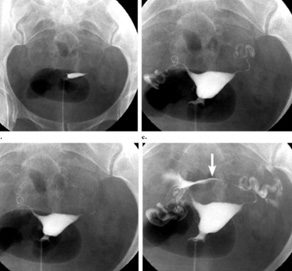What is Uterine Film (Hysterosalpingography - HSG)?
Why is uterine film (HSG) requested?
The uterine film reveals whether the tubes are open and if there is any structural abnormality in the uterus. It is requested to determine tubal blockages in women struggling with infertility. In cases of recurrent miscarriage or a history of preterm birth, uterine film may also be required. Not every patient undergoing in vitro fertilization (IVF) necessarily needs a uterine film, but if the uterine lining is not thick enough or if fluid accumulation in the tubes is observed on ultrasound, a uterine film may be requested before the operation.

What diseases can be diagnosed with HSG?
HSG can diagnose tubal blockages, fluid accumulation in the fallopian tubes (hydrosalpinx), adhesions in the uterus, structural abnormalities in the uterus, and lesions occupying space (such as polyps or fibroids).
Who should be recommended for HSG?
It is recommended for women struggling with infertility to determine if there are blockages in the tubes.
For patients with recurrent miscarriages, it is suggested to identify whether there is a structural issue in the uterus. E
specially after a history of dilation and curettage (D&C) or intrauterine operations resulting in decreased or ceased menstrual periods, HSG is recommended to detect adhesions in the uterus.
Is HSG always recommended for intrauterine artificial insemination (IUI) and in vitro fertilization (IVF)? What is the difference between them?
Before undergoing IUI, it is essential to confirm the openness of the tubes through Hysterosalpingography (HSG). However, for planned IVF treatment, HSG is not always necessary because even if there is a tubal blockage, fertilization of eggs with sperm can occur in the laboratory environment, rendering the blockage non-restrictive. However, if there is suspicion of fluid accumulation in the tubes or structural abnormalities in the uterus during an ultrasound examination, these can be confirmed with a uterine film.
When should the uterine film be taken?
One of the frequently asked questions is when the uterine film should be taken. The uterine film should be performed 1-2 days after the end of menstruation. It is taken by a gynecologist or radiologist.
How long does the uterine film take?
The uterine film is approximately a 10-minute procedure. It is recommended to be performed after the end of menstruation.
Does the uterine film open blockages?
If there is a mild adhesion in the tubes, the radio-opaque substance administered under pressure during the uterine film may open the tubes. Sometimes, with a method called selective salpingography, areas where catheter passage is difficult can be opened.
What is the cost of the HSG film?
The HSG film is taken in the radiology departments of state and private hospitals or imaging centers.
Is HSG a painful procedure? Does it require anesthesia?
Hysterosalpingography is generally a painless procedure and does not require anesthesia. If a patient has difficulty with vaginal examination, it can be taken under general anesthesia. If the patient has a vaginal or pelvic infection, it should be treated before Hysterosalpingography (HSG) is performed.
Is the radiation used in uterine film harmful?
The amount of radiation received during the uterine film is very low and, therefore, not harmful.
Does the uterine film increase the chance of pregnancy?
If there are minor adhesions or blockages, sometimes they can be opened during the uterine film, increasing the chance of pregnancy.